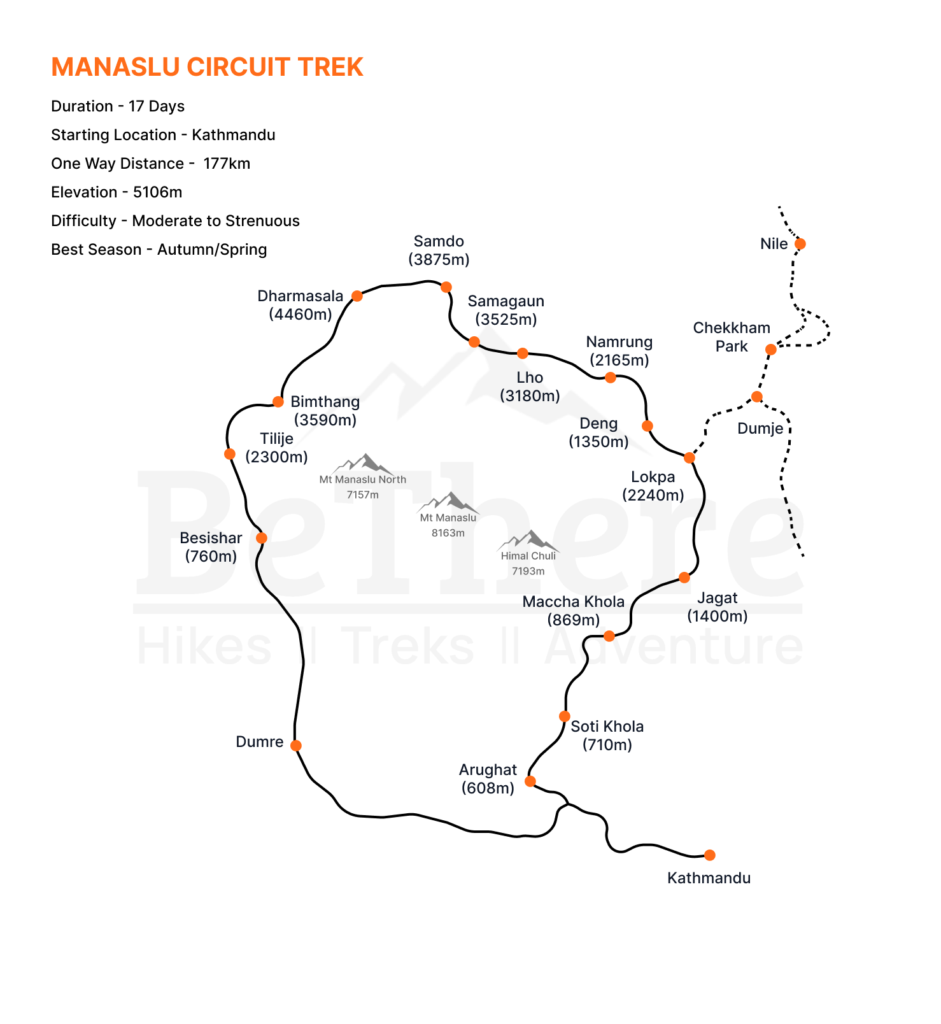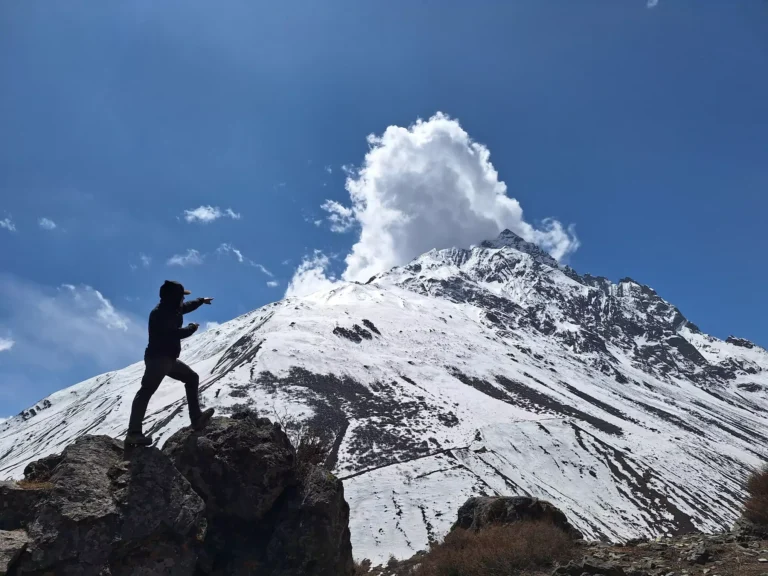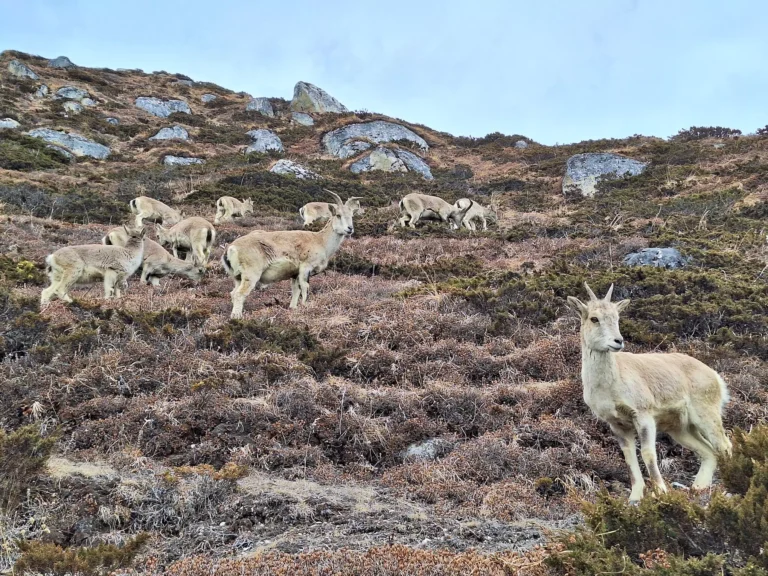Duration
17 Days
Max. Altitude
5106m
Difficulty Level
Moderate to Strenuous
One Way Distance
177Km
Start/End Point
Kathmandu
Best Season
Autumn/Spring
Duration
17 Days
Max. Altitude
5106m
Difficulty Level
Moderate to Strenuous
One Way Distance
177Km
Start/End Point
Kathmandu
Best Season
Autumn/Spring
Overview
The Manaslu Circuit Trek is a remote and unforgettable high-altitude adventure that loops around Mount Manaslu, which is the eighth-highest mountain in the world, standing at 8,163 meters (26,781 feet). This remote route in western Nepal offers a spectacular combination of raw natural beauty, rich cultural immersion, and challenging trekking conditions. Known for its pristine trails and fewer crowds compared to the Everest and Annapurna regions, the Manaslu Circuit Trek provides a truly authentic Himalayan experience.
This trek typically takes 17 days, depending on the itinerary and acclimatization days included. Starting in the lowlands of the Gorkha district, the trail gradually ascends through fertile hills and deep river gorges, before opening up to alpine meadows, glacial valleys, and breathtaking views of snow-capped giants like Manaslu, Himalchuli, Ngadi Chuli, and Ganesh Himal. The journey culminates with a dramatic crossing of the Larkya La Pass (5,106 m / 16,752 ft), one of the highest and most scenic passes in the Nepalese Himalayas.
The Manaslu Circuit Trek is a perfect choice for trekkers seeking solitude, challenge, and an immersive cultural journey. With its varied terrain, dramatic elevation changes, and untouched charm, it remains one of Nepal’s most rewarding and less-traveled trekking circuits, ideal for those looking to experience the Himalayas in their most authentic form.
Highlights of the Manaslu Circuit Trek
- The majestic centerpiece of the trek, Mount Manaslu, is the world’s eighth-highest mountain.
- Larkya La Pass offers panoramic vistas of Manaslu, Himlung, Cheo Himal, and the Annapurna range.
- Aside from Manaslu, enjoy views of Himalchuli, Ganesh Himal, Ngadi Chuli, Sringi Himal, and parts of the Annapurna Massif on clear days.
- The chance of spotting wild endangered species like the snow leopard.
- Add on hikes to the Manaslu Base Camp or Pungyen Monastery for acclimatization and even more spectacular mountain views.
- Engage and immerse in this region's rich local culture, blending both Hindu and Buddhist cultures.
- From Samdo village, you can trek to the border of Tibet.
- Visit culturally significant monasteries such as Ribung Gompa in Lho and the serene Pungyen Gompa with stunning views of the Manaslu Glacier.
Manaslu Circuit Trek Itinerary & Route Map
Day 01Arrive In Kathmandu (1,400m / 4,593ft), Transfer To Hotel
Welcome to Nepal. After landing at Tribhuvan International Airport, our representative will greet you and transfer you to your hotel.Our team will greet you and transfer you to your hotel, and take some time to rest or explore the vibrant streets of Thamel. You will be staying overnight in Kathmandu.
Day 02Kathmandu To Machha Khola Gaun (9-10 Hour Drive), Overnight In Tea House 900m/2953ft
After an early breakfast in Kathmandu. You’ll board a private vehicle and start the long but scenic drive toward Machhakhola, the starting point of your trek.
As you move beyond Dhading Besi and toward Arughat, the adventure truly kicks off, expect bumpy, dusty tracks carved into hillsides and glimpses of the Budhi Gandaki River roaring below. You will be staying overnight in Machha Khola to prepare for the trek to Jagat.
Day 03Trek To Jagat, 17km (1,410m / 4,626ft) (6-7 Hour Walk), Overnight In Tea House
Your first day on foot begins with the soothing sound of the Budhi Gandaki River flowing nearby. After breakfast, you’ll start trekking along a trail that alternates between rocky paths and well-trodden dirt trails.
As you continue, you’ll pass through the village of Khorlabesi, a quiet Gurung settlement, and possibly see local shepherds dressed in traditional Bokkhu (a coarse woolen cloak). You will be staying overnight at Jagat to trek to Deng.
Day 04Trek To Deng, 20km (1,804m / 5,919ft) (7-8 Hour Walk), Overnight In Tea House
Begin your day by ascending to Salleri, followed by a gentle descent to Sirdibas. The trail leads to Philim, where you’ll stop for permit checks. From here, continue along the western bank of the Budhi Gandaki River. After crossing the Siyar Khola Bridge, you’ll reach a fork in the trail where the route to Tsum Valley branches off to the right.
Stay on the main Manaslu Circuit as the path takes you across suspension bridges and through serene bamboo forests. The final stretch to Deng is peaceful and scenic, offering a quiet end to a fulfilling day of trekking.
Day 05Trek To Prok, 9km (2,318m / 7,604ft), Overnight In Tea House
After breakfast in Deng, begin your trek by crossing a suspension bridge and climbing gradually toward Rana and Bihi Phedi. The trail continues along terraced hillsides and forested paths with occasional glimpses of the surrounding cliffs and peaks.
Just after Bihi Phedi, the route branches, while the main trail heads toward Ghap, you’ll take the scenic and quieter path toward Prok. The sounds of birds and the scent of conifers make for a calming atmosphere as you ascend. You will be staying overnight here at Prok to prepare for the most challenging climb yet.
Day 06Acclimitaze Day In Prok, Hike To Kal Lake, 10 Km (8-9 Hour Walk) (3,574m / 11,725ft)
Today is one of the most rewarding yet demanding days of the trek. After an early breakfast, you’ll pack a lunch, along with snacks and chocolate bars for energy, and set off on a full-day hike to Kal Lake, a serene alpine lake perched high above the village of Prok.
Once you reach Kal Lake, you’ll be greeted by a peaceful, untouched landscape surrounded by towering peaks. From this vantage point, you’ll enjoy breathtaking views of Mount Manaslu, Ganesh Himal, and Siringi Himal, a truly unforgettable Himalayan panorama.
After spending some quiet time at the lake, you’ll descend the same trail back to Prok, where you can rest and recharge for the journey ahead. You will have to stay overnight at Prok to reach Namrung tomorrow.
Day 07Trek To Namrung 8km (4 -5 Hours Walk) Over Night In Tea House 2630m/8,629ft
Begin your day by descending gently toward the village of Ghap, passing through lush, moss-covered forests that feel almost enchanted. Along the trail, you’ll see traditional mani walls, stone structures inscribed with Buddhist prayers that add a spiritual atmosphere to your journey.
The trek concludes with a steady climb to Namrung, a picturesque village rich in Tibetan culture. Here, traditional stone houses cluster around welcoming teahouses, making it an ideal place to relax and experience local hospitality.
Day 08Trek To Shyala, 13km (6 – 7 Hours Walk) Over Night In Tea House 3875/12,713ft
After leaving Namrung, you will encounter many villagers dressed in traditional Tibetan attire. You’ll climb to Lihi and continue to Sho, where intricately painted kani (gate arches) mark the entrance, showcasing local artistry. Further along, the path becomes rockier as you make your way to Lho.
The trail leads through dense forest before reaching the peaceful village of Shyala. This quiet settlement surrounded by alpine scenery is an ideal spot to rest after a rewarding day of trekking. You will be staying overnight at Shyala.
Day 09Trek To Samagaun Via Pung Gyen Gompa, 13km (7 – 8 Hours Walk) Over Night In Tea House 3530m/11,582ft
The trail offers stunning views of Mount Manaslu. Passing through the tranquil village of Shyala, you’ll continue for about an hour along an easy path until you reach Sama Gaun, the largest and most important village of the Nubri region.
Sama Gaun features a large gompa (monastery), several shops, a health post, and even a heliport. Modern conveniences like telephone and Wi-Fi access are also available. This overnight stay in Sama Gaun is going to fuel you to reach Manaslu Base Camp.
Day 10Acclimatization Hike In Sama Gaun To Manaslu Base Camp (3,530m / 11,582ft)
Today is dedicated to acclimatization at Sama Gaun to help your body adjust to the increasing altitude and reduce the risk of altitude sickness. You’ll embark on a rewarding day hike to Manaslu Base Camp, gaining valuable altitude while enjoying some of the most spectacular mountain scenery in the region.
Carrying a packed lunch, you’ll follow the trail past Birendra Tal, a small alpine lake, before turning left onto the base camp route. The hike gradually ascends toward the northern edge of the Manaslu Glacier, culminating at the base camp situated at around 4,800 meters. Take your time to soak in the incredible views of towering peaks and expansive glacial landscapes.
After a rest and lunch break, you’ll retrace your steps back to Sama Gaun for a well-earned overnight rest.
Day 11Trek To Samdo, 8km (3 Hours Walk) Over Night In A Tea House 3860m/12,665ft
Leaving Sama Gaun, you’ll pass expansive yak pastures stretching across a broad valley dotted with long mani walls, where you might spot various alpine birds. Crossing the wooden bridge over the Budi Gandaki River before reaching White Kani, a charming village known for its yak herding traditions.
A short walk brings you into Samdo, a picturesque village surrounded by stunning mountain views. You can explore nearby smaller settlements or take an optional hike to Samdo Ridge to enjoy panoramic vistas of the Manaslu region and spend the night.
Day 12Trek To Dharmasala, 6km (3 – 4 Hours Walk) Overnight Stay In Tea House 4,460m/14,633ft
Today marks another high-altitude challenge on your trek. The trail leads you through rugged terrain with gradual uphill climbs, offering spectacular views of the surrounding Himalayan peaks.
As you walk steadily, the breathtaking landscape of the Manaslu region unfolds around you, with snow-capped mountains stretching across the horizon. The relatively short distance makes for a manageable day, allowing time to rest and acclimatize once you arrive at Dharmasala, a remote settlement offering basic teahouse accommodations.
Day 13Trek To Bhimthang, Larkya La Pass (5106m), 14km (9 – 10 Hours Walk) Overnight In Tea House 3590m/11,778ft
Today is one of the most memorable and demanding days of the trek, as you cross the highest point on the route, the Larkya La Pass at 5,106 meters. Prepare for an early start, as reaching the pass before midday is crucial to avoid afternoon weather changes that can bring snow and challenging conditions.
The ascent to Larkya La can be steep and tiring, but steady pacing will help you succeed. The effort is richly rewarded with spectacular panoramic views, including Himlung Himal (7,126m) near Tibet, Kang Guru (6,981m), and Annapurna II (7,937m) in the Annapurna range.
You will begin a gradual descent toward Bimthang. Along the way, marvel at immense icefalls and towering peaks surrounding Pongkar Tal, nestled between the Pongkar and Salpu Danda glaciers.
Day 14Trek To Tilije, 20km (7 – 8 Hours Walk) Overnight In Tea House 2,300m/7,564ft
You’ll cross the Dudh Khola River and make your way to Karche, where you can enjoy a well-deserved lunch break. As you continue, the route then descends to Gurung Goa, the first significant village since Samdo, signaling a return to more settled, agricultural terrain.
The valley opens up into a more cultivated and fertile landscape, dotted with fields and groves of oak and rhododendron trees. You’ll follow the north (true right) bank of the river as you approach the welcoming village of Tilije, where you’ll spend the night.
Day 15Trek To Dharapani (1940m/6364ft), 5km (2-Hour Walk) And Drive To Besisahar (760m/2493ft) (4 Hours’ Drive)
After breakfast, you’ll begin the final day of trekking along a wide trail to Dharapani. Due to recent landslides, the road remains closed to vehicles, so walking is necessary. Upon arrival in Dharapani, your private vehicle will be ready to pick you up.
The drive from Dharapani to Besisahar takes approximately four hours on a bumpy, sometimes rough road. Besisahar is a bustling market town where you can explore local shops, relax, and stretch your legs after the trek.
Day 16Drive To Kathmandu (1400m/4593ft) (3 – 4 Hours’ Drive), Transfer To Hotel
Start your day with an early morning drive to Kathmandu in a private vehicle, helping you avoid the city’s typical traffic congestion. The journey takes about six hours, offering scenic views along the way as you leave the mountains behind and return to the bustling capital.
Whether you choose to shop for souvenirs, stroll through the vibrant streets of Thamel, or relax in a cozy café, it’s the perfect opportunity to soak in the city’s unique atmosphere and reflect on your incredible trek.
Day 17Departure For Home
After having breakfast, you will be transferred from your hotel to Tribhuvan International Airport for your onward flight. As you leave Nepal, take with you unforgettable memories of the majestic mountains, vibrant cultures, and warm hospitality.

Includes/Excludes for Manaslu Circuit Trek
- Arrival & Departure (Round Trip)
- Twin Sharing Accommodation in Kathmandu
- Manaslu Special Permit
- TIMS Card, Conservation Entry Fee & Insurance for Staff
- Transportation: Luggage & Members
- Food (B/L/D) in the Hotel
- English-speaking guide and porter (2 trekkers: 1 porter)
- International Flight
- Lunch & Dinner in Kathmandu
- Extra Night in Kathmandu (in case of early arrival/late arrival/)
- Rescue Evacuation (if required)
- Personal Expenses (beverages, laundry, personal trekking gear and equipment)
- USD 30 for an extra porter (if demanded)
- Tips for Guides and Porters
Note
Please note that due to ongoing road construction along the Prithvi Highway, the drive from Kathmandu to Pokhara has become more time-consuming and dusty than usual. While this journey typically takes around 6–7 hours, current conditions may extend it to 8–9 hours due to traffic congestion and air pollution. We kindly ask for your patience and understanding during this transitional period.
Gears & Equipment
Item
Quantity
1 set of base/thermal Layer and 1 mid-layer
1
1 Set outer layer
1
1 waterproof jacket and 1 waterproof trousers, or raincoat/punchoo instead.
1
1 pair of lightweight trekking trousers or zip-off pants.
1
2 trekking t-shirts/shirts-merino is ideal
2
Four Season Sleeping bag.
1
Four Season Down Jacket.
1
1 pair liner gloves
1
1 warm wool hat
1
1 sunhat or similar
1
Sleeping bag liner
–
Travel towel
–
Sunscreen
–
Moisturizer
–
Lip Balm
–
Toilet Paper
–
1 rucksack/duffle bag for the porters to carry with your overnight kit
1
1-day pack (approx. 30ltr) with a waterproof cover
1
2 x 1ltr water bottles or CamelBak
2
1 x head torch
1
Water purification tablets
–
1 pair trekking boots (must be worn in)
1
Sandals or hut shoes
–
3 pairs thick walking socks / 3 pairs lighter walking socks
3
Running Shoes or sneakers.
1
Power bank
–
Thermal Flask
–
Adaptors: Nepal uses Type D, C and M
–
Best Time to Trek Manaslu Circuit
The best time to trek the Manaslu Circuit is during the spring (March to May) and autumn (September to November) seasons. These periods offer the most stable weather conditions, clear mountain views, and comfortable daytime temperatures, ideal for high-altitude trekking.
- Spring (March–May): This is a vibrant time to trek, with blooming rhododendrons, lush greenery, and excellent visibility. The trails are alive with color and relatively quieter than the Annapurna or Everest routes.
- Autumn (September–November): Widely considered the peak trekking season, autumn offers crisp air, dry trails, and exceptional views of the Manaslu range. It’s the best time for photography and crossing Larkya La Pass safely.
While it’s possible to trek in winter (December–February) or during the monsoon (June–August), these months come with challenges such as heavy snow, cold temperatures, or slippery trails due to rain and landslides, making them less favorable.
Food and Accommodation
During the Manaslu Circuit Trek, teahouse-style accommodation is available in most villages along the trail. These are locally run lodges that provide a cozy place to rest, typically featuring twin-sharing rooms with basic bedding and communal dining areas. In higher elevations, the lodges can get colder at night, so a good-quality sleeping bag is recommended.
- Food: Trekkers are served hearty meals to keep energy levels up, with menus offering a mix of local Nepali and Tibetan cuisine, as well as some Western dishes. Expect staples like dal bhat (rice and lentils), Tibetan bread, momos (dumplings), noodles, soups, pasta, and eggs. In higher altitudes, food choices may narrow slightly due to remoteness and supply challenges.
- Drinks: Tea, coffee, and safe boiled or filtered water are widely available. Bottled water is discouraged due to environmental concerns, so it’s best to carry purification tablets or a reusable filtration bottle.
- Facilities: Most teahouses offer basic amenities like solar-heated showers (for an extra cost), charging stations (often with a fee), and simple squat or western-style toilets. Wi-Fi may be available in a few places but is generally unreliable, perfect for those looking to disconnect.
Food and accommodation during the trek are simple but satisfying, contributing to the unique and authentic cultural experience of trekking in one of Nepal’s most remote and beautiful regions.
FAQs
Where is the Manaslu Circuit Trek located?
The Manaslu Circuit Trek is located in Gorkha, the western Himalayan region of Nepal, which is near the border to Tibet. This trek circles Mount Manaslu, which is considered the 8th highest peak in the world
Where is the starting point of the Manaslu Circuit Trek?
The starting point of the Manaslu Circuit Trek is Machha Khola, because a road was constructed later that allowed the route to be shortened compared to the previous gateway, Arughat.
What are the highlights of the Manaslu Circuit Trek?
The highlights of the Manaslu Circuit Trek include:
- Views of Mount Manaslu (8,156m), Ganesh Himal, Annapurna II, and other peaks.
- A chance of spotting wild endangered species like the snow leopard.
- Crossing a challenging pass, Larkya La Pass is considered one of the longest passes in the Himalayas.
- A chance to explore alpine meadows and dense rhododendron forests.
- Cross dramatic suspension bridges over the Budhi Gandaki River
How long is the Manaslu Circuit Trek?
The length of the Manaslu Circuit Trek can last anywhere from 12-26 days, depending on rest, travel to and from Kathmandu, and the difficulty of the trek.
How difficult is the Manaslu Circuit Trek?
The Manaslu Circuit Trek is considered moderately challenging since it requires a good level of fitness, acclimation to high altitudes, as well as a good mental fortitude to adapt to fatigue and discomfort.
What permits are required for the Manaslu Circuit Trek?
Getting these allows you to trek flawlessly, as it allows you to trek Manaslu. The permits you need to obtain to trek Manaslu are:
- Manaslu Restricted Area Permit (MRAP)
- Manaslu Conservation Area Permit (MCAP)
- Annapurna Conservation Area Permit (ACAP)
When is the best time for the Manaslu Circuit Trek?
The best time for the Manaslu Circuit Trek is typically during the spring (March to May) and Autumn (Sept – Nov) as during these times there are stable weather conditions, clear mountain views, and comfortable daytime temperatures, ideal for high-altitude trekking.
Need help with your trek?
Reach out to our travel experts
Starts at
USD $1250 $1100 / Minimum 2 Pax
Plan Your Hike

Nepal🇳🇵
What Trekkers are Saying About Us
Bhasmasur Hill was challenging but rewarding with its stunning views. Subash Ghimire’s tips about local culture and nature brought the hike to life for me. It felt like a real adventure, and his friendly attitude kept the group motivated.

Timo Janssen
Traveler from Netherlands
Shivapuri Peak was a perfect challenge for me, tough enough to feel like an accomplishment, but the views were worth every step. The whole experience was seamless thanks to BeThere. They took care of all the planning, so I could just enjoy the hike and nature.

Hannah Brooks
Traveler from USA
Bishnudwar was a quiet, beautiful hike, just what I needed to get away from the daily grind. Alexander Lama knew all the best spots for photos and even pointed out some wildlife. I couldn’t have asked for a better guide.

Nathan James
Traveler from New Zealand
The trail to Nagi Gumba was peaceful and absolutely stunning. BeThere fun made the trip feel so organized and stress-free, from start to finish. I loved being surrounded by nature, just a short drive from Kathmandu.

Rachel Bennett
Traveler from UK
Nagarkot was everything I hoped for beautiful forest trails, fresh air, and incredible valley views. The trip was well arranged by BeThere, which allowed me to relax and focus on the experience without any worries.

Felix Schmidt
Traveler from Germany
Lobuche Peak was intense but rewarding. Subash Ghimire made sure we were ready for the climb and kept spirits high with his friendly attitude. This was one of my favorite trekking experiences by far.

Giulia Bianchi
Traveler from Italy
Need help choosing a trail?
Connect with a local and plan your perfect trek.


